Horses have evolved to be able to sleep standing up. But, interestingly, horses actually sleep standing up and laying down. These two positions produce different kinds of rest:
- 😴 Why horses stand up to sleep: Standing sleep helps horses recharge while allowing them to stay alert and ready to react quickly if they sense danger. For horses, standing-up sleep is equal to a short human nap on the sofa: it’s restorative but not deeply restful.
- 😴 Why horses lay down to sleep: If they feel safe enough, horses will lay down to sleep. Laying down to sleep helps horses get deep, restful REM sleep.1 For horses, lying down produces sleep patterns similar to what people experience during a good night’s rest in their bed.
How Much Standing Sleep Horses Need
Because lying down to sleep was risky in the wild, horses evolved to need just 30 minutes of lying down sleep each day2 Horses spend 4 to 15 hours a day in standing rest.3 Combined with this short lying down sleep, periods of standing sleep throughout a day provide all the rest a horse needs.
Table of Contents
The Anatomy of a Standing Horse Nap
Horses’ ability to sleep while standing isn’t by accident! Over millions of years, wild horses developed a unique muscle and bone structure that allowed them to doze while staying upright. These horses could respond faster if a predator approached.
The Mechanics of Standing Sleep
Horses have a unique ability to stand for long periods with minimal muscle activity, thanks to a specialized structure called the passive stay apparatus.4 The passive stay apparatus helps horses conserve energy while sleeping standing up
How does it work?
This passive stay apparatus involved in equine standing sleep involves three things:
- 🦴 Bone structure – the bones in horses’ legs are “stacked” in such a way that they remain straight with very little energy exertion.
- 💪🏽 Tendons & muscles – the stabilizing tendons in horse legs are positioned so that even at rest, or with a very small amount of tone, they provide stabilization to the bones.
- 🪑 Four legs – a sturdy chair is much more stable than a bicycle. This same concept of four legs offering stability is key to how horses stay standing and balanced while asleep.
Together, these 🦴 stacked bones, 🪑 quad-balanced anatomy, and 💪🏽 well-evolved muscles help horses sleep standing up without losing their balance or having their legs buckle.

Horse Sleeping Positions
According to Sue McDonnell,5 who studied horse behavior in the 1990’s, horses sleep in three ways: standing, laying on their side, or laying on their belly/chest.
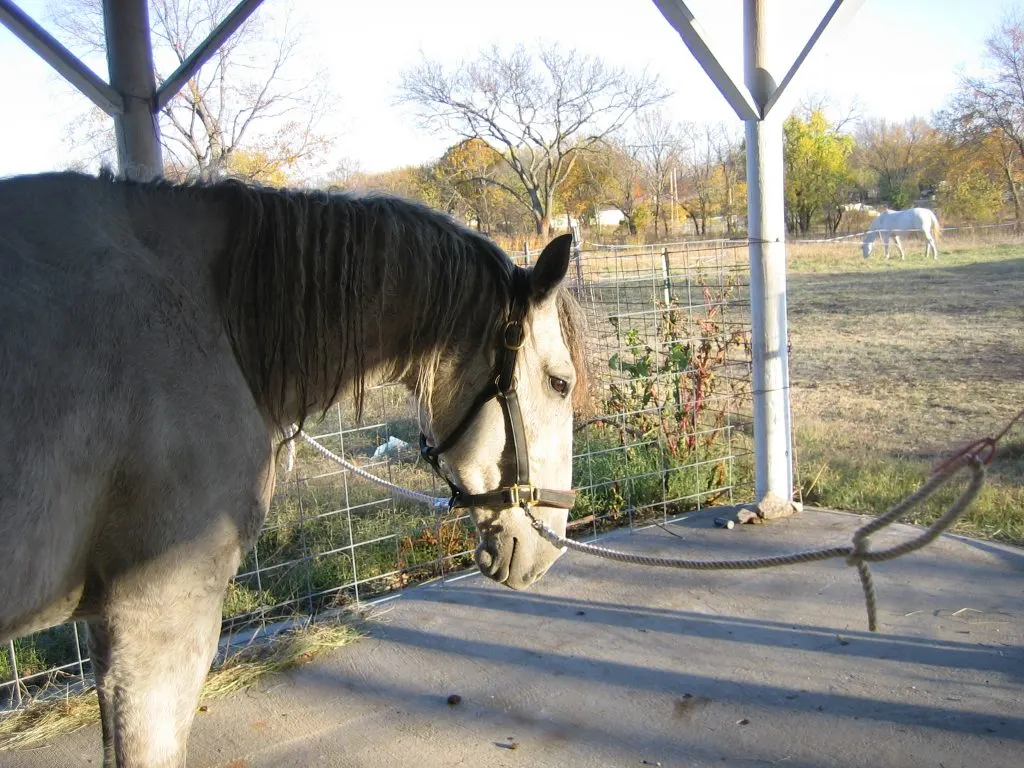
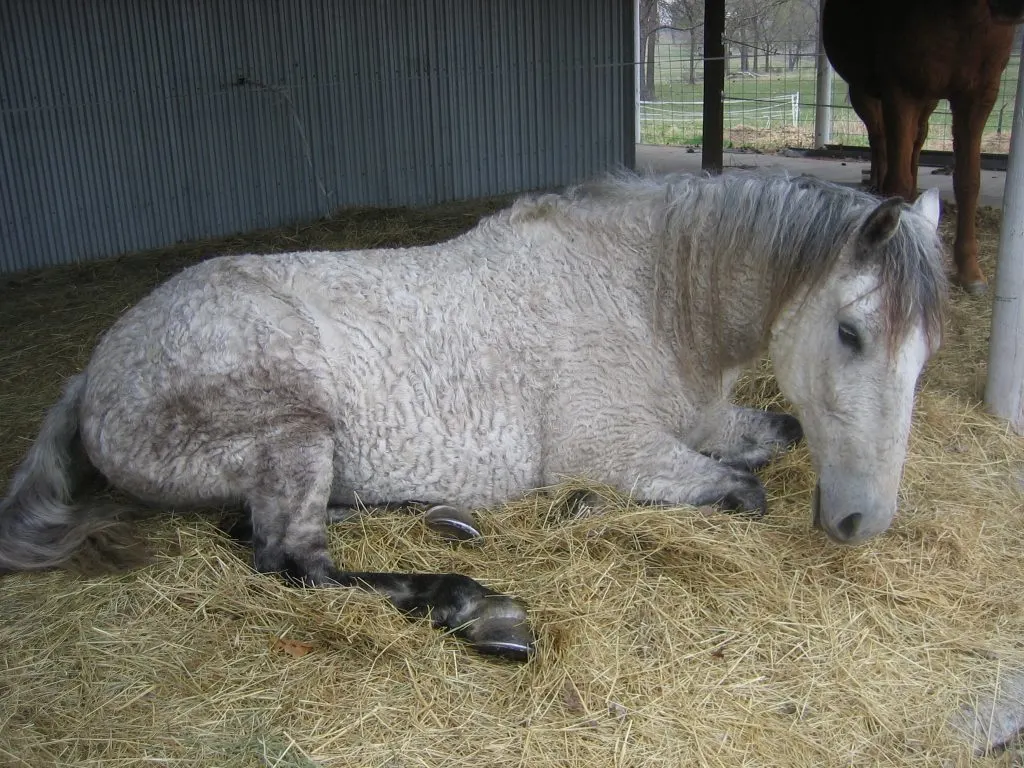
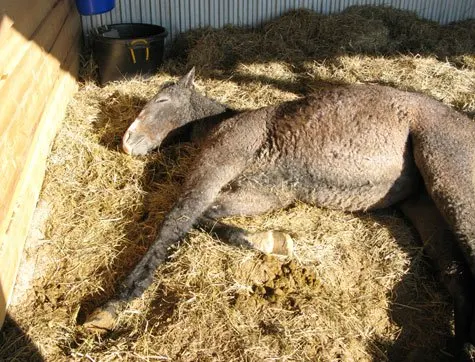
Lateral Recumbency (laying flat) Lateral recumbency is the horse sleeping position that’s most confusing for non-horse people. People are sometimes VERY concerned when they see a horse fully relaxed.
When Horses don’t Sleep Well
A horse will typically manage their own sleep well. However, sleep disorders are possible in all mammals, including horses. One cause of a horse not sleeping well is a disagreeable housing situation- such as spending nighttime pasture turnout with a herd with a bully.
Reasons horses might sleep standing too much
Even though horses can sleep standing up, they need a little time laying down each night. If they only get standing sleep, horses might be irritable, more prone to startle, or bite. Reasons horses might not sleep well include:
- nightime turnout with unbonded horses
- new/unfamiliar environment
- light pollution
- physical pain
- uncomfortable footing/stall bedding
Horses rely on the security of a herd to sleep safely, trusting that their herd will help keep them safe as they sleep. If your horse isn’t sleeping because of herd dynamics or a particular horse that bullies them, try switching up your horse’s nighttime routine. Spending the night in a stall (or switching stalls, if your horse already is stabled at night) may help improve your horse’s sleep quality.
Fact: When horses sleep outdoors in herds or indoors in communal stalls, you’ll never see a group of horses laying down at once. Instead, one horse always remains standing as a “lookout” who helps the recumbent horses sleep more soundly.
As you watch your herd, notice which horse most frequently stands and if all of the horses are laying down without a standing sentinel. If one horse is standing most of the time, it may be a cue that that particular horse does is not bonded well with his herd and is not able to rest easily in their company. If all the horses lay down regularly, it’s a good sign that your horses feel safe on your farm and comfortable in their herd dynamics.

Have you ever wondered why horses sleep standing up instead of laying down like other animals? It turns out, that myth is only half true. It is true that horses are able sleep standing up, but to enter deep, restful sleep a horse actually does need to lay down.
In the wild, horses are prey animals. Horses are able to sleep standing up because if a predator was to attack a herd of horses, the horses would lose precious escape time scrambling to their feet. A horse off its feet is more vulnerable to attack. But horses do lay down on their sides to sleep for periods of time, usually at night.
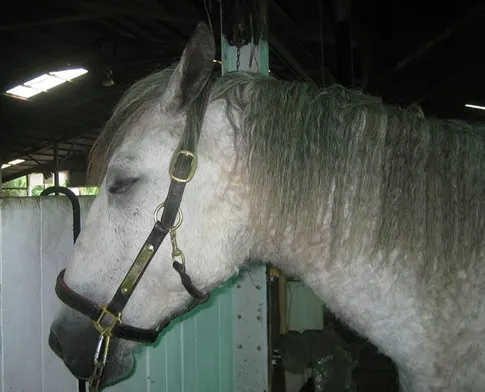
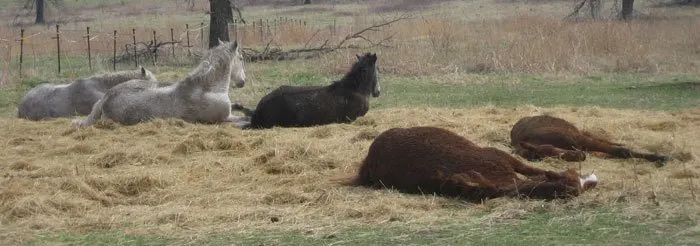
Why Don’t I See Horses Sleeping?
Because horses have spent millennia as prey animals, their bodies are hypervigilant. That means they have evolved to be alert and reactive to the smallest stimuli.
You might have missed catching your horse sleeping because your horse was able to hear you coming. Horses that hear someone coming are often startled to alertness (if sleeping standing up) or jump to their feet (if lying down).
Many of the pictures of horses “sleeping” I’ve been able to capture as a horse owner and amateur photographer are actually photos of horses in the middle of rolling, such as the photo of my grey curly gelding who appears to be sleeping in a near-fetal position.
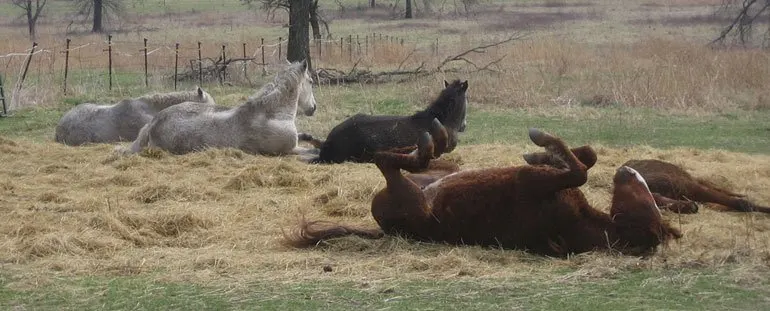
Standing vs Lying Down Sleep Periods
Horses should lie down at some point each day or night, in order to get quality sleep, but should not lay down for many hours a day. If your horse stays lying down for more than a few hours, it’s worth a call to your emergency vet.
What Makes Horses sleep standing vs laying down
Researchers have investigated what makes a horse decide to sleep standing up or lying down. They found that horses chose sleep positions based on the following factors:
- 🛏️ Bedding Type : Straw > Shavings – Horses lie down more on straw bedding (about 44 minutes) compared to shavings or straw pellets (about 21.6 minutes).6
- 📏 Bedding Depth : Thicker is better – Horses sleep standing up more if the ground is hard (outdoors) or if their stall bedding (indoors) isn’t deep.
- 💡 Light Conditions – Researchers found that 3-10 lux lighting affects the sleep 🌙 hormone melatonin in horses. Horses with adequate melatonin are more likely to have restful sleep standing up and laying down.
- Understimulation – Horses stabled overnight face an environment that is much calmer than an open pasture. You might think this would improve sleep, but it can actually be a problem. Horses may be more alert due to isolation, confinement, and being less able to identify the source of sounds.7 Researchers found that playing classical music at night at 68 decibels (similar to the volume of a washing machine) improved sleep quality for horses.7
- 💡🌙 Artificial Lights: Can disrupt sleep – light pollution- both indoor and outdoor- is theorized by researchers to disrupt horses’ sleep and affect how much sleep they get in all positions.
Defining Healthy Limits for Standing vs Lying Down Sleeping for Horses
One study found that on average, horses spent about 67.4 minutes lying down per day. Young horses with lameness problems lay down for the longest (85 minutes), followed by old horses with lameness (59.7 minutes), then old healthy horses (36.5 minutes), and finally, young healthy horses (64.1 minutes).8
| Average Time Spent Lying Down (minutes) | |
|---|---|
| Young Horse with Lameness | 85.0 |
| Old Horse with Lameness | 59.7 |
| Old Healthy Horse | 36.5 |
| Young Healthy Horse | 64.1 |
The same study found that draft horses tended to lie down more (88 minutes per day) than warmbloods (58 minutes) or other breeds (69 minutes).8 No research study currently compares ponies vs minature horses when it comes to sleep.
Why laying down to sleep for too long is dangerous for horses
Fact: Horses have an interesting circulatory system. The movement of muscles and ligaments in the legs helps to move blood throughout the body. When horses lay down to sleep for too long, their heart may struggle to pump oxygenated blood to all their limbs. Quickly, this can become an emergency.
Healthy horses lie down regularly for an hour or two at a time, but too much laying down is dangerous.
| 📞👨🏽⚕️ Call a Vet When | 🚫👨🏽⚕️ Don’t Call a Vet When: |
| A horse lays down for 3hrs+ | You never see your horse laying down |
| A horse struggles to stand up | You see a horse fully recumbent |
Some horse owners train their horse to lay down on command. For tips on training this trick, check out our tutorial on training a horse to lay down.
My Experience Learning about Horses Sleeping Standing Up
When I became a horse owner, I worried a lot about my first horse and all aspects of his life! How, I wondered, would I know if he was getting enough to sleep? How would I be able to tell if he wasn’t sleeping well?
I knew that horses sleep standing up, but I also grew up in the country and had regularly seen horses laying down in fields- so I wasn’t sure what to think!
As I learned more about horse-keeping I learned that horses can sleep standing up or lying down, but their sleep is deeper when they do lay down. As prey animals, horses have to be careful about when and where they lie down to sleep.
Frequently asked questions:
Do horses sleep on their side?
Horses may sleep on their side (called Lateral Recumbancy) or on their belly, with their legs tucked up underneath them (called Sternal Recumbancy). Lateral recumbent sleep offers horses deeper sleep, but horses must feel very safe in their stall, pasture, or herd to sleep this way.
Are horses nocturnal?
Horses are very adaptable in their sleep patterns. While horses are generally awake during the day and asleep at night like humans, horses adapt well to a practice many horse owners use during the hottest months of the summer in which horses are turned loose in pastures to graze in the cool of the night, and put up in stalls in a shaded barn (usually with fans helping them stay cool in the heat) during the day.
Horses’ sleep patterns are very different than ours – they rest by dozing on and off throughout the 24 hour period. Humans on the other hand have a much more set wake/sleep cycle. While it’s hard for humans to try and shift their sleep schedule, horses adapt well to it.
How much do horses sleep?
According to veterinary researchers, horses need about 30 minutes of laying down sleep each day, and will spend about 12% of their day napping while standing up.9
- Williams, D. C., Aleman, M., Holliday, T. A., Fletcher, D. J., Tharp, B., Kass, P. H., … & LeCouteur, R. A. (2008). Qualitative and quantitative characteristics of the electroencephalogram in normal horses during spontaneous drowsiness and sleep. Journal of veterinary internal medicine, 22(3), 630-638. [↩]
- Burla JB, Rufener C, Bachmann I, Gygax L, Patt A, Hillmann E. Space Allowance of the Littered Area Affects Lying Behavior in Group-Housed Horses. Front Vet Sci. 2017 Mar 7;4:23. doi: 10.3389/fvets.2017.00023. PMID: 28326309; PMCID: PMC5339441. [↩]
- Chung, E. L. T., Khairuddin, N. H., Azizan, T. R. P. T., & Adamu, L. (2018). Sleeping patterns of horses in selected local horse stables in Malaysia. Journal of Veterinary Behavior, 26, 1-4. [↩]
- Gussekloo, S. W., Lankester, J., Kersten, W., & Back, W. (2011). Effect of differences in tendon properties on functionality of the passive stay apparatus in horses. American journal of veterinary research, 72(4), 474-483. [↩]
- McDonnell, S. M. (2003). The Equid Ethogram: A Practical Field Guide to Horse Behavior. United Kingdom: Eclipse Press. https://www.google.com/books/edition/The_Equid_Ethogram/-Mvm9NjH0WUC?hl=en [↩]
- Greening, L., Downing, J., Amiouny, D., Lekang, L., & McBride, S. (2021). The effect of altering routine husbandry factors on sleep duration and memory consolidation in the horse. Applied Animal Behaviour Science, 236, 105229. [↩]
- Hartman, N., & Greening, L. M. (2019). A preliminary study investigating the influence of auditory stimulation on the occurrence of nocturnal equine sleep-related behavior in stabled horses. Journal of equine veterinary science, 82, 102782. [↩] [↩]
- Kelemen, Z., Grimm, H., Long, M., Auer, U., & Jenner, F. (2021). Recumbency as an Equine Welfare Indicator in Geriatric Horses and Horses with Chronic Orthopaedic Disease. Animals, 11(11), 3189. [↩] [↩]
- Carson, K., & Wood-Gush, D. G. M. (1983). Equine behaviour: II. A review of the literature on feeding, eliminative and resting behaviour. Applied Animal Ethology, 10(3), 179-190. [↩]

